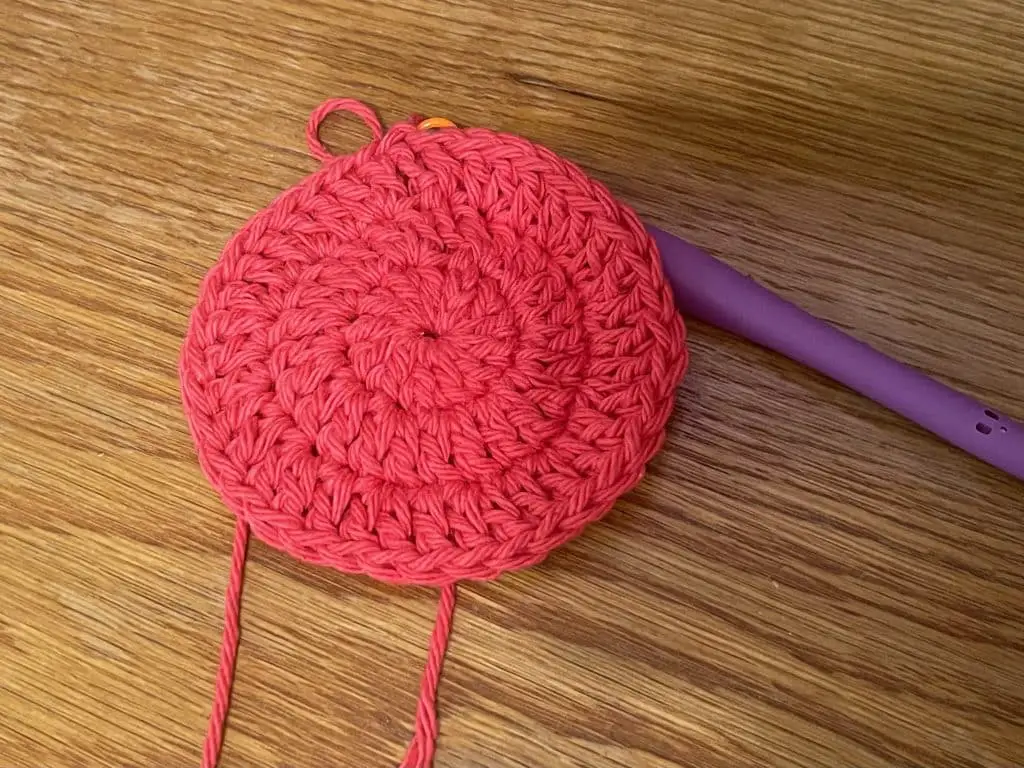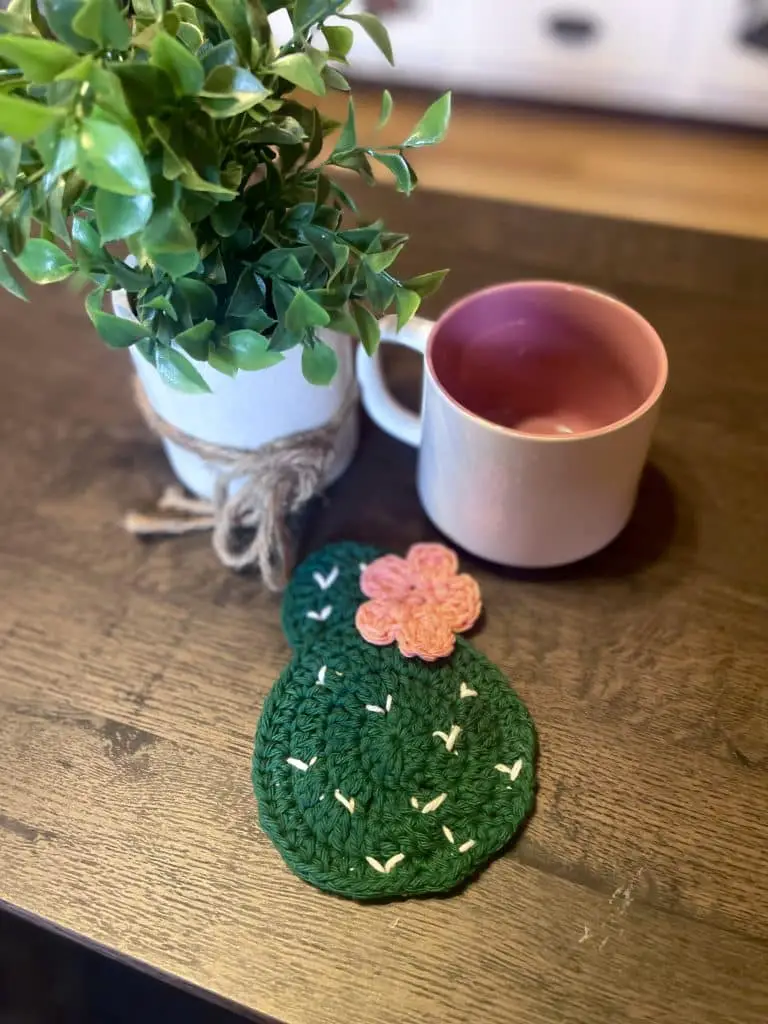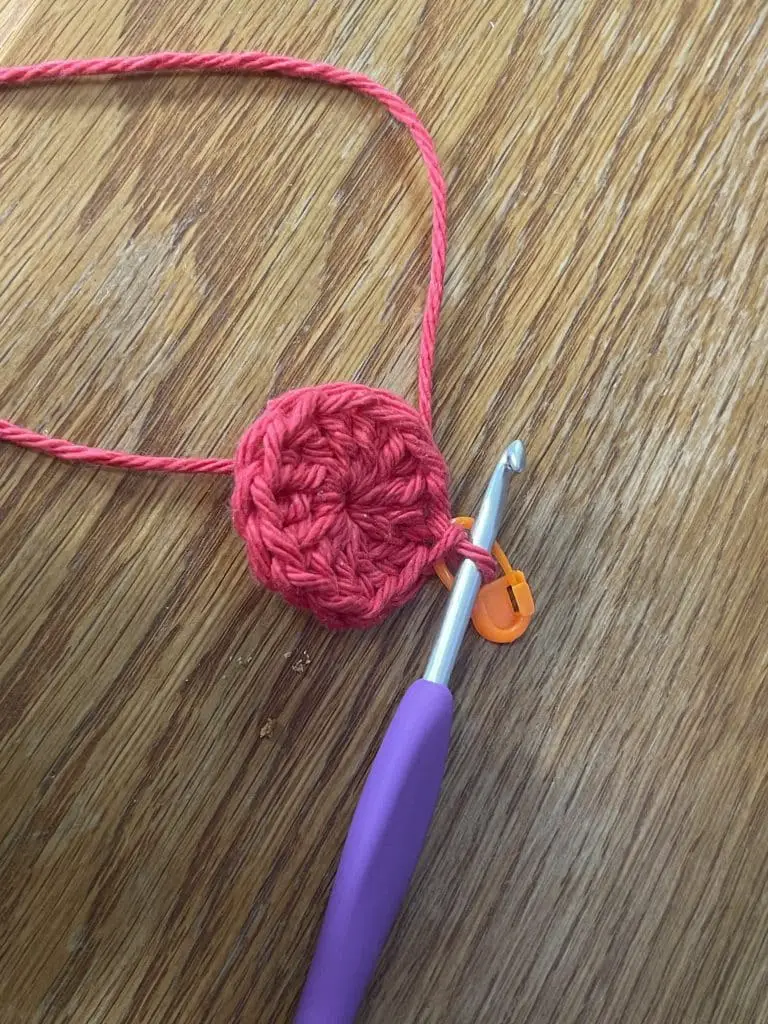Hey y’all!
I love cacti, and I love making coasters. (If you haven’t noticed that from my last few posts on coaster crochet patterns….) They’re just so fast and easy to make. Plus I love displaying what I make in my house. So if you’re interested in a free cactus coaster crochet pattern, read on.
The downloadable PDF of the double crochet coaster is available on my Etsy or my Ravelry.

And if you need any help getting started with amigurumi or crocheting, I have an article on the ultimate guide to amigurumi that goes over different yarn types and weights and how to do the basic stitches.
If you have any questions, feel free to contact me on one of my socials.
Or you can email me at [email protected]. I’d love to see pictures when you make one! Enjoy 🙂
Disclosure: This post may contain affiliate links and I may receive a commission if you purchase through them, at no extra cost to you.
Terminology (US):
SC – single crochet
MR – magic ring
INC – increase
DEC – decrease
R – round
HDC – half double crochet
DC – double crochet
TR – treble
CH – chain
Difficulty: Easy
Tools and materials:
How to Make a Crochet Cactus Coaster
Yarn
The type of yarn you use is very important for a coaster. Some types of yarn will melt under heat or not absorb liquids as well as others. Plus, being washable is pretty important for a coaster. You can either use cotton or wool, but cotton is my favorite.
Why use cotton yarn for a crochet coaster?
- Absorbency: Cotton yarn is great for absorbing moisture. So if you set a cold drink on a cotton coaster, it’ll absorb any sweat from it. And if you happen to spill anything on it, that will be absorbed as well.
- Durability: Since coasters are frequently used, they need to be durable. Cotton yarn is great for this as it’s very durable and can withstand daily use.
- Heat Resistance: Keeping hot drinks from burning your furniture is an important function for a coaster. Cotton yarn can withstand the heat from beverages without melting. This makes it a great choice.
- Easy to Clean: Most cotton yarn is able to be put in the washing machine on the gentle cycle. This makes it much easier to clean than other yarns that would have to be hand-washed.
- Variety: There are many different textures and colors available for cotton yarn. Some are super soft. Some are coarse. Some are solid colors. Some are multicolored. This allows you to create coasters that match your personal style and home decor.
- Environmentally Friendly: Cotton is a natural plant-based fiber, making it biodegradable and more environmentally friendly than synthetic alternatives.
- Minimal Stretching: Cotton yarn has minimal stretching compared to some other fibers. This helps the coaster maintain its shape and size over time.
These are the basic characteristics of cotton yarn. However, always check the label of the specific cotton yarn that you buy to make sure there aren’t any specific instructions.
Yarn I Used
For these crochet mushroom coasters, I used Peaches and Cream weight 4 medium cotton yarn. I really like this yarn for coasters specifically because it feels very durable and is a bit coarser than other cotton yarns that I’ve used. I love soft cotton yarn for hats and headbands, but I like a bit more sturdy cotton for a coaster. That could just be me though.
Any type of weight 4 cotton yarn will work for this pattern!
Stitches Used in This Pattern
Slip Knot: tutorial by SarahMaker
Here’s a helpful video tutorial.
Pattern Notes:
- The big and small cactus in this free cactus coaster crochet pattern is a circle but with DC and HDC. If you’re used to amigurumi or making circles with SC, when I say to do 2 DC in same stitch and then 1 DC in the next 1 or 2 stitches, that translates to (inc, SC x 1 or 2) in SC terms. Please reach out for any questions!
- The downloadable PDF of the cactus coaster crochet pattern is available on my Etsy.
Free Cactus Coaster Crochet Pattern steps:
Big Cactus:
R1:
- Slip knot
- Chain 3
- In the second stitch from the hook (the first that you chained), do 12 DC
- Pull the center closed
- Slip stitch into the first DC
(12 stitches in the circle at the end of the round)
R2:
- Chain 2
- Make 2 DC in each stitch
- Slip stitch into first DC
(24 stitches in the circle at the end of the round)
R3:
- Chain 2
- Alternate between 2 DC in same stitch and 1 DC in next stitch until the end of the round
- Slip stitch into first DC
(36 stitches in the circle at the end of the round)

R4:
- Chain 1
- Do 2 HDC in same stitch, and then 1 HDC in the next 2 stitches. Repeat until end of round.
- Slip stitch into first DC
(48 stitches in the circle at the end of the round)
Fasten off and weave in ends
Little Cactus:
R1:
- Slip knot
- Chain 3
- In the second stitch from the hook (the first that you chained), do 12 DC
- Pull the center closed
- Slip stitch into the first DC
(12 stitches in the circle at the end of the round)
R2:
- Chain 2
- Make 2 DC in each stitch
- Slip stitch into first DC
(24 stitches in the circle at the end of the round)
Fasten off and weave in ends. Sew to the underneath in the
top right corner of big cactus.
Flower:
R1: MR 6
R2:
- (slip stitch, HDC, DC x 3, HDC) in same stitch x 5 (makes 5 total petals around the circle)
- slip stitch in last stitch
Sew on flower to small cactus. Sew it closer to the top of the small cactus to leave more room for cups.
Sew on white spikes
Suggested crochet tools:
- A crochet hook – I recommend a pack that comes with every size, but if you’re on a budget, you can just get the hook size that the pattern uses. I use this crochet hook pack from Amazon. I had to superglue a couple of the hooks to the handles after awhile, but it’s a cheap starting point and I like the feel of the handles.
- Stitch Markers – To me, these are essential. Without them, you’d have to be 100% accurate with your stitch counting each round to know where the round ends. But, luckily, my recommendation is super cheap. I use these stitch markers from Amazon. I’ve used them for a couple years with no complaints. They’re my favorite over others I’ve used.
- Safety Eyes (and maybe noses) – Probably 99% of amigurumi requires safety eyes. I use these from Amazon and it conveniently comes with a little case.
- Stuffing – Another amigurumi essential. I’d also say 99% of amigurumi requires stuffing. I buy this giant bag off of Amazon and I haven’t had to buy any for a few months. (I normally crochet smaller things, not big plushies, so take that as you will)
- Tapestry Needle – Needed to sew yarn in a lot of projects. I honestly can’t remember where I got the ones I use.
- Scissors – Needed for cutting the yarn. Any scissors will do. The best would probably be fabric scissors though. I got a pair from Joann Fabrics.
- Yarn – Use whatever yarn weight the pattern calls for. I tend to always use acrylic yarn. The cheapest I’ve found is Red Heart Super Saver Yarn. I love it and I don’t feel like I’m spending a fortune on yarn all the time.
- Crochet Ring (optional) – Not necessary, but if you wrap the yarn around the loop a couple times it keeps the tension nice and tight. Might be helpful if you’re a beginner and keep your hands from cramping up. I use these from Amazon.
OR
- All-in-One Crochet Pack – You can get this all-in-one crochet pack that has everything you need to get started.
More Free Crochet Patterns
Easy Circle Coaster Pattern (both SC and DC versions.)
Free Mushroom Coaster Crochet Pattern
And that’s all folks!
Hope you enjoyed this free cactus coaster crochet pattern. Let me know if you have any questions. And don’t forget to pin this post on Pinterest to save it for later!
Pattern Terms of Use:
This pattern is for personal use only. Do not redistribute. Any redistribution of this pattern is theft. You may sell the finished product. Credit AbiesCustomDesigns for the pattern and use your own photos. Tutorial videos or written instructions of this pattern are prohibited.
@Copyright AbiesCustomDesigns 2023 by Abigail Spencer
All Rights Reserved




